
"MEN CALL ME
THE PHANTOM
STRANGER
IF YOU WISH YOU
MAY COME WITH ME...
FOLLOW ME, AND WE
SHALL SEEK THE ANSWERS TOGETHER"
PLOT SUMMARY
! SPOILER
ALERT !
The Phantom Stranger
witnesses a young woman contemplating suicide by
jumping from a bridge and succeeds in convincing
her to reconsider her actions and step down from
where she is standing. However, when she tells
the Phantom Stranger that her name is Gola and
takes his hand, she fells him with a burst of
psychic energy.
As the Phantom
Stranger lies motionless on the ground, what
appears to be a private ambulance pulls up.
Taking orders from one Doctor Nathan Seine, two
crooks heave the Phantom Stranger's body into a
coffin.
Having loaded it
into the ambulance, the strange party heads out
to a mysterious estate where Seine checks on his
terminally ill wife, Margaret. She is kept alive
by an array of machines which her husband
carefully oversees, ignoring her agony and her
begging to let her die.
|
|
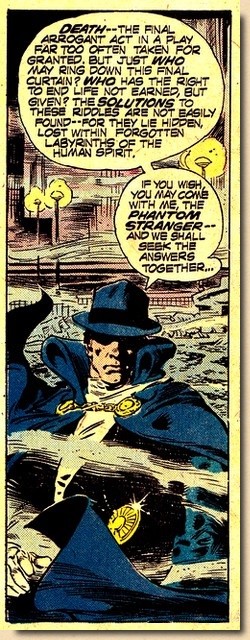 |
|
| |
At this
point, Seine's thoughts drift off to his past and he
reflects on how exactly it came to be that he and his
wife find themselves where they are now.
|
| |
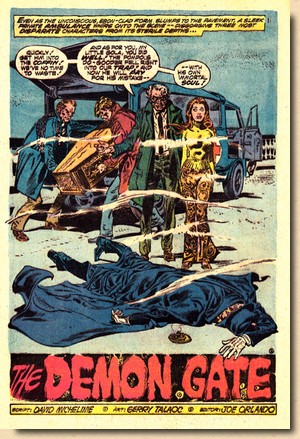 |
|
Once a brilliant biochemist,
Seine was always hampered by his insecurity and
lack of confidence in himself. Things changed,
however, when he coughed up the courage to ask
Margaret to marry him - from then on, Seine felt
confident in his work and his life. The price,
however, was a growing need to have Margaret at
his side which gradually turned into an
obsession.
He thus made his
wife his laboratory assistant even though she
lacked any experience and expertise in the field.
When the inevitable happened - an explosion in
the lab which all but killed Margaret, Seine
simply refused to let his wife go.
Using his specialist
knowledge he designed life-supporting machines
which, however, did nothing more than simply
sustain his wife in her terrible state of
existence. Realizing that the machines could only
delay the inevitable and that his wife was still
going to die, Seine abandoned science and turned
to the occult in desperation.
Delving deep into
dark secrets and ancient mysterious texts, Seine
learned how to summon demons from Hell who
promised him Margaret's life in exchange for a
passage to the mortal realm so they could freely
spill out into the world of the living. Following
instructions, Seine crafted a soul-stealing
gemstone to power such a gateway between Earth
and Hell, but a mortal human soul proved too weak
- only that of the Phantom Stranger would be
powerful enough.
|
|
| |
| But when Seine and his
goons check on the Phantom Stranger they find the coffin
empty... |
| |
| Appearing
out of the shadows, the Phantom Stranger
effortlessly takes out his muscle men and then
turns to Seine, but he has Gola cast a string of
life draining chains around the Stranger who then
loses his consciousness... Coming to again but bound by
chains, the Phantom Stranger tries to reason with
Seine, to no avail. Doing the same with Gola
would be useless, as Seine tells the Stranger
that she is merely a mystical automaton, built
from nothing but sand and spells, and under
Seine's total command and control.
Proceding with the
dark ritual, Seine begins to siphon off the
Phantom Stranger's soul and the gateway begins to
open. At that very moment, fighting back her pain
with an iron will and mustering her last bit of
energy, Margaret pulls herself up and, stumbling
forward, releases the Phantom Stranger.
|
|
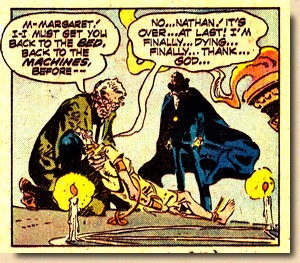 |
|
| |
| He reduces Gola to the pile
of sand she was cast from, and as Seine lunges at the
Phantom Stranger he slips on the sand and shatters the
soul gem. As the Stranger's soul flows back into him, the
gateway closes. Margaret dies in her husband's arms, her
suffering finally at an end, but Seine is blind to her
relief and accuses the Phantom Stranger of having killed
her,vowing vengeance... |
| |

REVIEW &
ANALYSIS
The
Phantom Stranger, created by John Broome and
Carmine Infantino in 1952, is one of only a
handful of comic book characters which truly
elude a clear-cut characterization: Having
originated from
unspecified paranormal circumstances, he battles
mysterious and occult forces, but his identity,
reasons and motives ultimately remain unknown and
unclear.
This air of
vagueness which surrounds the character is
sometimes mirrored in his stories, which back in
the 1970s (and in which was actually volume 2 of
the series) could take on all kinds of differing
tones and directions.
|
|
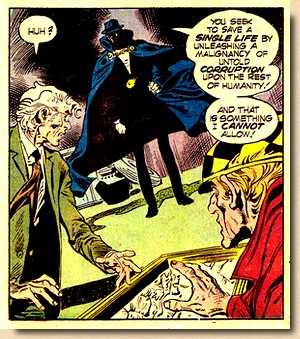 |
|
| |
| This is
certainly also true regarding David Michelinie's story
for Phantom Stranger #35, which is at its core
very somber as it deals with the death of a loved one and
the highly controversial subject matter of how far
life-supporting measures should be allowed to go on. The
plot does move on rather quickly and at times erratically
so, but then Michelinie only had 12 pages at his
disposal. Some elements require a total suspension not
only of disbelief but also logic, but as this is a
supernatural title at its core readers can be expected to
just follow any twist and turn in the storyline.
Characterization is rather shallow with the exception if
Doctor Nathan Seine, but again: 12 pages make for an
awfully short done-in-one story.
All in all, it's like
the Phantom Stranger himself - you just can't put your
finger on it.
The artwork
for Phantom Stranger #35 came from Gerry Talaoc,
who was amongst the Filipino artists recruited by DC (and
Marvel) in the early 1970s. Talaoc was mainly assigned to
horror and war titles and was the regular Phantom
Stranger artist from issue #27 (October 1973) to issue
#37 (June 1975); the series was cancelled in February
1976 with issue #41.
The
characteristic visuals of the Phantom Stranger, however,
had been worked out and laid down by Bill Draut, Neal
Adams and Jim Aparo with their cover artwork when the
title was relaunched for a second volume in May 1969. The
first three issues featured reprint material from the
original 1952 series but included both new introductory
story-framing artwork and said covers. Aparo took over
from Adams and Sekowski as interior penciller with issue
#7 (May 1970) and continued to provide the artwork for
the stories until Talaoc took over as of issue #27
(October 1973), but Aparo also pencilled and inked
numerous covers for the series (after Adams left the
title in that function as of issue #19), and the cover of
Phantom Stranger #35 is an example of this work.
|
| |
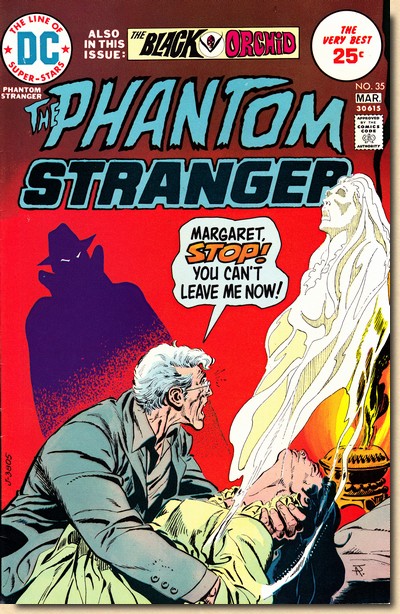
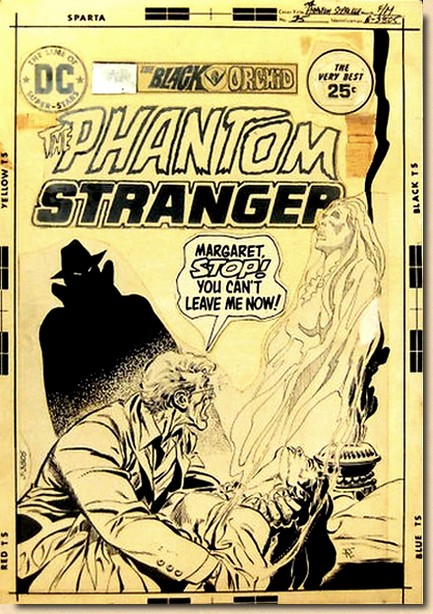
Original artwork by Jim Aparo for
the cover of Phantom Stranger #35 (scanned from the
original);
the paste-up for the issue number and month has come
loose at one time and was subsequently lost
|
| |
| |

|
| |
FACTS
& FIGURES
"The Demon
Gate" was reprinted, albeit in black and
white only, in 2008 in Showcase Presents
Phantom Stranger #2. DC's mystery character par
excellence never really saw any coverage
outside the US market; an almost singular
exception is Italian publisher De Agostini who
put out the first of the Phantom Stranger
Showcase reprint volumes in 2008 as Lo
Straniero Fantasma. This ran up to issue #25
and therefore did not include "The Demon
Gate", but the second volume never happened.
Doctor Nathan Seine,
who vehemently vows revenge at the end of the
story, would indeed return - he was back in Phantom
Stranger #37-38 and #40-41.
Knowingly or
(probably) not, the opening of Phantom
Stranger #35 harks back to Phantom
Stranger #1 (vol 1, August 1952), when the
character first stepped into a panel of a DC
comic book - also to save a woman from jumping
from a bridge.
|
|
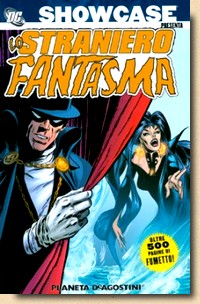 |
|
| |
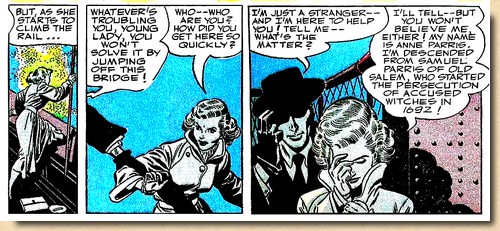 |
|
Written by John Broome and
pencilled by Carmine Infantino the development of
the Phantom Stranger was a pioneering move, but
in the growingly hostile environment towards
comic books at the time, supernatural themes were
best toned down.
What seemed to be
supernatural events at the outset of a story
would thus be proven to be hoaxes by the Phantom
Stranger in his 1952/53 series.
As such, the character was
operating on that fringe of gothic horror fiction
which E. A. Poe had been a master of exploring.
|
|
| |
| Another
identifying trait missing from the original
series is the role of narrator and host, a
concept which framed all the stories of the
second volume. It was a plot device taken
straight from old time radio shows of detection,
mystery and horror, where listeners would be both
warned and invited to witness what was about to
unfold.
As with some of those old
radio shows, the Phantom Stranger was host,
narrator and involved character all at the same
time - although the latter didn't always
guarantee a very active role.
"The
Phantom Stranger never really got noticed by
most of the audience because it was a mystery
book, not really a character book. The
Phantom Stranger was rarely the focal point
of the story. He was the host, he was the
interlocutor, the interjector, he just showed
up at the right moment, and ran away."
(Len
Wein in Slifer 1979)
This was also a
constant point raised in letters sent to the
editor. Some did not like the artwork since Aparo
stopped doing the interiors, while others did not
approve of some recuring characters which writers
had started to introduce. But they all seemed to
agree that they wanted the Phantom Stranger to
play a more active role in the stories.
|
|
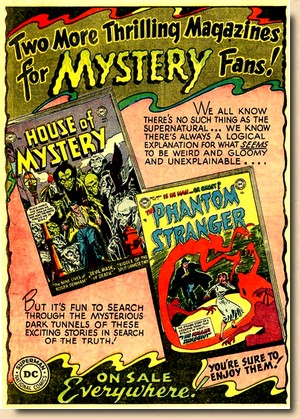 |
|
| |
|
| |
| As always,
the in-house ads add some interesting period information.
In this case, the list of titles advertised for
subscription wasn't too long, but the ad for Amazing
World of DC Comics - their self-produced fan magazine -
is notable. |
| |
| |
| BIBLIOGRAPHY
SLIFER
Roger (1979) "Lein Wein
Interview", in: The Comics Journal
#48 (August 1979)
|
|